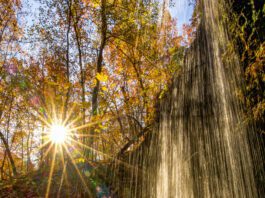
Oklahoma is home to a wide variety of animals, many of which are indigenous to the state. Gray foxes, bobcats, barred owls, eastern box turtles, gray squirrels and southern flying squirrels are just a few of the creatures you can find scurrying throughout the state.
“Oklahoma is blessed when it comes to fish and wildlife,” says Jena Donnell, communications and education specialist at the Oklahoma Department of Wildlife Conservation. “There are species like the red-tailed hawk and red-eared slider that are relatively common and do well in a mix of landscapes,” she says. However, the red-eared slider is on the list of the world’s 100 most invasive species.
“There are also species like the Sequoya slimy salamander or Delaware County cave crayfish that are only known to occur in Oklahoma,” Donnell says. The Sequoya slimy salamander is endemic to the Ouachita Mountains, while the cave crayfish resides in only three caves in Delaware Country, making them critically endangered.
Most of the species in Oklahoma are doing well, but there are a few, like the cave crayfish, that are struggling. More than twenty species of plants and animals that occur in Oklahoma are threatened or endangered, according to the U.S. Fish and Wildlife Service.
“The Wildlife Department U.S. Forest Service manages a small population of endangered red-cockaded woodpeckers in McCurtain County,” says Donnell. The woodpecker suffers from habitat fragmentation, as their pine trees are continuously removed.

Being Environmental Stewards
What can we, as everyday citizens, do to be better stewards to the environment?
“In general, wild animals need wild spaces,” says Donnell. “Some species require large tracts of undeveloped land that mimic historic conditions. For those, maintaining native habitat on Wildlife Management Areas, National Wildlife Refuges, or nature preserves can provide the greatest benefit.”
However, plenty of animals do well in smaller spaces.
“Maintaining native plants and other habitat elements in a pasture or backyard can provide food, water and cover to a wide range of wildlife and benefit species on a local level,” says Donnell. Plenty more information about landscaping for wildlife can be found at wildlifedepartment.com.
Safely Interacting
Interacting with wildlife is also a wonderful activity that anyone can take part in. Even better, you can form a community through your observations.
“Oklahomans can experience wildlife in their backyards, at local parks, state parks, Wildlife Management Areas, National Wildlife Refuges and nature preserves,” says Donnell. “You can have positive encounters regardless of your experience or comfort level. It doesn’t matter if you’re a fledgling or experienced naturalist, if you’re watching from a window or hiking miles from the trailhead.”
If you come across a fun sighting and find yourself taking plenty of photos, sharing them is a great way to get involved with other naturalists.
“One way to reinforce your experiences and increase awareness/appreciation for Oklahoma’s wildlife is to share your sightings on free nature platforms like iNaturalist or eBird,” says Donnell. “Documenting the what, when and where details of your sighting can help you remember your wild encounters, help fellow naturalists plan their next adventure, and help biologists learn more about Oklahoma’s wildlife.”



